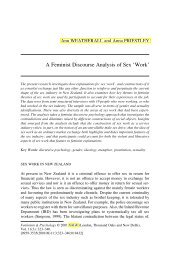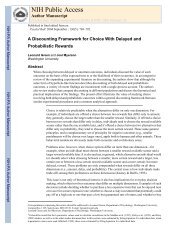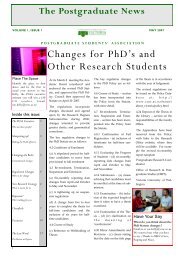Perner 2010.pdf
Perner 2010.pdf
Perner 2010.pdf
Create successful ePaper yourself
Turn your PDF publications into a flip-book with our unique Google optimized e-Paper software.
Page 258258 <strong>Perner</strong>behavior rules but also to minimize the behaviorist connotations and emphasizethat they are probably not conscious rules of the animal reflectively thinking: “ah,when he directs his gaze to . . .” etc”5 It also taints Premack and Woodruff’s (1978, p. 526) snappy defence of mentalism:“the ape could only be a mentalist . . . he is not smart enough to be abehaviorist.”6 These S→A CIPs are called “Behavior Rules” because part of the situation S isthe other individual’s behavior, which also needs to be observed for inferringfurther behavior, i.e., the action A.7 One could use “want” here. Two important points about the use of “want” in thiscontext: (1) Although a mental term is used, it is a quasi-“observable” fact of whatP wants, because one is told it in the story. (2) Although we classify “want” as amental state, it is an open question as to whether it is understood by children (oradults in routine cases) in this way. It can also be understood as a goal specification:he is going to get the object. Hence, I express it in this sort of neutral way.8 In the name of simplicity these arrows cover up much of the actual structure ofthe needed inference rules. For instance: IF P does not see an unexpected transfer,THEN he will think O is at the original location where he last saw it. It is notoriouslydifficult to find rules that cover our mentalist competence. Fortunately, thepresently relevant point is just that whatever rule is needed here, it can be adoptedin the formulation of behavior rules (see below).9 The rule underlying this arrow must stipulate something like: IF P wants to get O,THEN P will go to where he thinks O is. With further reasoning: Since he thinks itis in L1, we will arrive at the prediction that he will go to L1.10 Here too, a great simplification. The actual rule underpinning this arrow would besomething like: IF P is going to get O, THEN he will go to where he last saw O.The important general lesson is not the formulation of a specific behavioral rule,but that some rule is necessary for inferring either the future behavior or P’smental states and that the behavior can be inferred from the same observationalbasis as the mental states.11 My concern about this was raised when asked the question by Dan Povinelliduring the “Other Minds” conference at the University of Oregon in Eugene,September 2003.12 One may wonder how Call and Tomasello’s nonverbal false-belief test couldbe solved by behavior rules. Let us find out by following my recipe for applyingPovinelli’s Challenge: We need to first specify mentalist rules for solving thistask, e.g.:NOT FOR DISTRIBUTIONA person, who looks at an object in a box and does not look when this box isexchanged with an identical looking one, will think the object is now in the replacementbox. If the person is to mark the box with the object inside, the person willwant to mark the box where she thinks the object is, i.e., the now-empty replacementbox. The person marks the box on the left, so the object must be in the other box.This is a surprisingly great feat of reasoning for 4- or 5-year-old children, but abehavior rule approach does not make it more complicated. Only the first twosentences have to be reformulated:IF a person (who looks at an object in a box and does not look when this box isexchanged with an identical looking one) is supposed to mark the box with theobject inside, THEN the person will mark the box where the object was when shelooked inside, i.e., the now empty replacement box. ...13 Most impressively, due to sophisticated eye-tracking equipment, one can literallyPerception, attention, and action:International Perspectives on Psychological Science (Volume1). Peter A. Frensch and Ralf Schwarzer (Eds). 2010.Published by Psychology Press on behalf of the International Union of Psychological Science.This proof is for the use of the author only. Any substantial or systematic reproduction,re-distribution, re-selling, loan or sub-licensing, systematic supply or distribution in anyform to anyone is expressly forbidden.15:58:17:03:10Page 258






